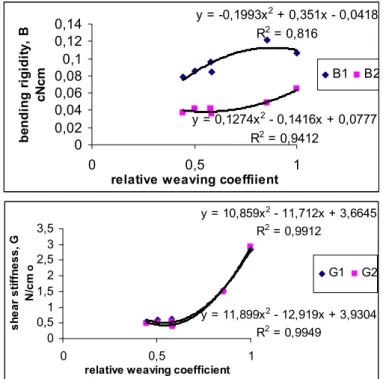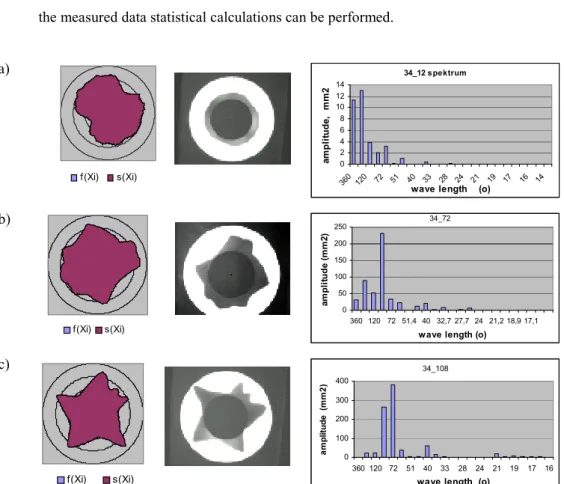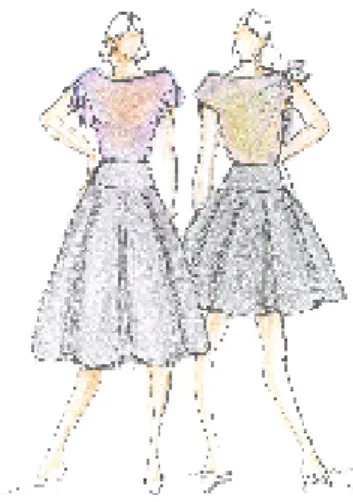University of Western Hungary, Faculty of Wood Engineering
József Cziráki Doctoral School of Wood Sciences and Technologies Sciences of Fibre Technology
PhD thesis
Ex E xa am mi in na at ti io on n o of f d d ra r ap p e e a an nd d h ha an nd d o of f f fa ab br ri ic cs s f fo or r 3D 3 D m ma at te er ri ia al l s s im i mu u la l at ti io on n f fo o r r g ga ar rm me en n t t m ma an nu uf fa ac ct tu ur re e
Lívia Kokas Palicska
2008
Doctoral School: József Cziráki Doctoral School of Wood Sciences and Technologies
Programme: F4 Fibre Sciences (Director: Prof. Dr. András Winkler)
Discipline: Material sciences and technologies
Consultant: Dr. Iván Szücs
3
1 Objective and scientific antecedents of the research work
Interest in computerized depiction of clothes has been growing in recent years. The reason of this is that revolutionary new service is going on in the clothing industry that enables to intervene in the design process immediately according to the customer’s demand through exact digitalization of spatial figures on a virtual prototype. Because of the increasing competition in the clothing industry and of the shorter life cycle of fashion goods searching for new tech- nologies is going on all over the world. One of the results of this development process is that, parallel with development of computerized simulation, 3D CAD technology is used in many factories at production design and preparation processes. Taking of measurements from a person is carried out with body scanner using laser or white light radiation that saves the exact measurements in several minutes. The body scanner then forwards the data to a computer which is able to depict the parameterized model through developed simulation systems, on basis of the actual measurements.
Fabric simulation and spatial design carried out with 3D CAD technology is useful not only for the clothing industry but for other fields too, where textile cover should be fitted to spatial shapes (like in case of technical textiles used by the construction industry and packaging industry, or for upholstery of furniture or vehicles, etc.).
Simulation of fabrics is quite difficult because of their strong tendency to change shape under low force and because they have complicated anisotropic and non-linear features. It needs creating an adequate material model. For real-time simulation of exact depiction of their real behaviour exact mechanical measuring, material models and complex numeric solutions are required.
Aim of the present thesis is to contribute with its results to the virtual depiction of textile fabrics that approaches the reality in a better way. For this purpose the Author examined the property of the fabric which can be used for computerized modelling. This property is draping ability of the fabric which, being complex change of shape, plays important role in aesthetic valuation but, at the same time, it determines the possibility of correct fitting to the form of the fabric as well as its spatial formability.
With knowledge of the measuring methods of drape and hand of fabrics, being introduced in this thesis, it became reasonable to develop a procedure that is able to describe the draping deformation in a complex way but with simple method and by which the information given can be used in wide range.
1.1 Objectives of the research work
Objectives of the research work can be formulated as follows:
Development of a new computerized valuation method that is able to give more information on draping properties of textile fabrics than those well known ones that evaluate the static draping and by which sources of errors of the traditional manual methods can be eliminated.
Examination of the material parameters of textile fabrics that are necessary to model the draping properties. This examination includes the influence of fabric structure and finishing treatment to draping.
Examination of conclusions drawn from the results concerning their availability.
To prove that this method of experiment design can be well used by professionals of garment manufacture and by designers who carry out experiments with new materials.
1.2 Test methods
The research works focused on the mechanical properties of textile fabrics that have influence on the change of shape under little force (pull, bending, shearing, press) during manufacturing or wearing of the garments.
The Author registered the mechanical properties connected with drape and hand of cotton, cotton/linen and viscose rayon woven fabrics (these were prepared mainly expediently but partly chosen by leaving to chance), using Kawabata’s KES-FB and Cusick’s methods. For measuring of fabric drape the new computerized evaluating method developed by the Author herself, the Sylvie 3D Drape Tester developed by the Budapest University of Technology and Economics and the Korean Drape Analyser program were used. Tests were carried out in the textile technology laboratory of the Budapest Tech Polytechnical Institution, in the Budapest University of Technology and Economics and in the University of Maribor.
Pieces of information on draping given by the Author’s new method were used also to optimal realization of a stylist’s envision. Results given by design of experiment enabled the estimation of dependence of outputs being important for garment manufacture from fabric parameters as inputs.
5
2 Summary of the new scientific results
The Author’s new and, comparing to the usual ones, more effective method offers complex information on drape properties of textile fabrics. Computerized evaluation eliminates the possible sources of errors of the traditional manual evaluation.
Starting point at developing of the new method was that the form of the projection of a circular specimen which droops from the supporting surface is a closed curve that can be interpreted as a sum of periodical functions where the independent variable is the central angle. The continuous range of angles was substituted for discrete values produced by measured signals of draping. Since these discrete points of the outline curve of projection of the draping specimen are determined by distance from the centre (radius) and the central angle, thus the periodical curve can be described as Fourier series.
To apply this method the Author used a new computerized program, developed by herself with assistance of some colleagues, which is available to evaluate the digitalized image of draped specimens. This program determines the coordinates of outline points of the projection which will be used for the harmonic analysis as well as the surface area of the projection from which the drape coefficient can be calculated. The Author suggests introducing a new parameter for valuation of draping: this is the spectral function which represents the amplitudes of harmonic components of periodical functions as function of their wave-length. She examined whether this new method is suitable through the changes of spectral function to compare various textile fabrics and to show the differences under various outer effects.
The Author carried out complex mechanical examinations to analyse the influence of the most important parameters being determinant for draping (like fabric construction and finishing) and she received new pieces of information, given by the spectral function, on draping in connection with spatial fitting of the fabrics. She quantified the effect of softening treatment of viscose, cotton and cotton/linen woven fabrics on draping. She proved that the spectral function changes with change of the specimen dimensions: in case of larger specimen the wave-length of main components determined by harmonic analysis is shorter.
It is characteristic that textile fabrics change their shape in time if stress in the fabric changes, for example during relaxation. The Author’s experiments proved that in case of a circle speci- men which droops 9 cm deep (this was the greatest droop in the experimental series) the shape of spectral function changed in time, because during sinking of the support plate outside forces affected the specimen.
It was proved by using multifactor design of experiment that parameters of draping can be well used in product development. Results enable the stylist to realize his/her envision in short time in form of an optimal prototype, thus the period of product development can be shortened.
3 Theses
Thesis No. 1
There is significant relation between weave construction and draping properties of the woven fabric. The higher is the so called relative weaving coefficient the higher are the drape coef- ficient, the bending rigidity and the relative shear stiffness of the fabric. It was found that these connections in case of the tested fabrics can be approached by quadratic equations (Fig. 3-1).
1.3 From the approaching quadratic equations it was deduced that change of weave construction has stronger influence on shear stiffness than on bending rigidity. Shear stiffness of a plain fabric of tight structure is three times higher than that of a cotton twill fabric.
y = -0,1993x2 + 0,351x - 0,0418 R2 = 0,816
y = 0,1274x2 - 0,1416x + 0,0777 R2 = 0,9412
0 0,02 0,04 0,06 0,08 0,1 0,12 0,14
0 0,5 1
relative weaving coeffiient
bending rigidity, B cNcm B1 B2
y = 11,899x2 - 12,919x + 3,9304 R2 = 0,9949
y = 10,859x2 - 11,712x + 3,6645 R2 = 0,9912
0 0,5 1 1,5 2 2,5 3 3,5
0 0,5 1
relative weaving coefficient
shear stiffness, G N/cmo G1 G2
Fig. 3-1. Bending rigidity (B) and shear stiffness (G) of various fabrics vs. relative weaving coefficient. (1– warp direction; 2 – weft direction)
1.2 Bending rigidity and shearing stiffness versus linear density of weft yarns show linear relation, but, on the contrary, bending rigidity and shear stiffness versus weft density (the number of weft yarns counted in unit length) can be approached by quadratic polynomial
7
Thesis No. 2
It was proved and quantified by the Author that mechanical, chemical and thermal treatments, carried out in the dyeing and finishing process, have significant influence on draping of the fabrics.
2.1 After softening treatment with silicon agent the draping factor decreased by 20% and strong decreasing of anisotropy could be also observed at the viscose rayon fabric. In consequence, the fabric became more shapable and could fit better to a spatial form.
Using double quantity of softener agent on the same fabric, the draping factor decreased by 26%. The same softening treatment exerts greater effect on fabrics made from finer yarns or on fabrics of less area density
2.2 Drape coefficient of linen woven fabrics can be reduced by 25% when chemical softening treatment and mechanical finishing (breaking) are used together.
2.3 Drape coefficient of a raw (unfinished) cotton woven fabric decreases by 10% in average when the fabric is boiled at 95 °C. On the contrarty, drape coefficient increases by 24% when the fabric is ironed on an industrial press.
Thesis No. 3
The Author developed a new evaluation method for measuring the drape which is more effective and gives more information than the usual ones.
To describe fabric drape the Author introduced a new parameter, the spectral function of draping. Basis of this is that it was found that the projected and digitalized wave curve shown when the tested circle specimen was drooping from the support plate could be expanded in series for harmonic analysis.
3.1 Outline of the projection of a draped specimen is a wave curve which can be approached by Fourier polynomial. Its harmonic components can be depicted as lineal spectral func- tion of wave-length expressed in angle. The Author proved that this spectral function is available to represent the drape ability and gives reproducible results.
3.2 The Author proved that the spectral function developed by herself is available for quanti- tative analysis of ability to draping in a fast and objective way and it gives more complex statistical data on draping than the test methods used usually. A certain periodical com-
ponent can be read from the spectral function by which the draping curve can be ap- proached with the best result (dominant wave-length). The number and wave-length of harmonic components can be seen as well, inference can be drawn to the size of drapes, to the number of drapes of various wave-lengths and to the symmetry of draping.
3.3 The Author proved with the new parameter that the spectral function given by specimens from the same fabric changes with change of the diameter of the specimen and hence with increasing of the drooping length. The longer is the drooping length the less is the drapes coefficient and the shorter are the wave-lengths of drapes (Fig. 3-2).
3.4 The Author proved through the spectral function that draping of a woven fabric is con- stant when droop is 6 cm and when no outer force influences the fabric. Thus, on basis of the measured data statistical calculations can be performed.
a)
f(Xi) s(Xi)
34_12 s pektrum
0 2 4 6 8 10 12 14
360
120 72 51 40 33 28 24 21 19 17 16 14
wave length (o)
amplitude, mm2
b)
f(Xi) s(Xi)
0 50 100 150 200 250
360 120 72 51,4 40 32,7 27,7 24 21,2 18,9 17,1 wave length (o)
amplitude (mm2)
34_72
c)
f(Xi) s(Xi)
34_108
0 100 200 300 400
360 120 72 51 40 33 28 24 21 19 17 16 wave length (o)
amplitude (mm2)
Fig. 3-2. Projection and spectral function of tested specimens.
a) 3 cm droop, b) 6 cm droop, c) 9 cm droop
9
Thesis No. 4
The Author proved through her research work that the spectral function contains also quality information to compare textile fabrics.
4.1 The spectral function is available to compare draping ability of various textile fabrics as well as to reveal the effectiveness of softening treatments applied in the finishing proc- ess. She proved that in case of softened fabrics main components of the harmonic com- ponents of the wave curve (which represents the draping) are displaced in direction of shorter wave-length.
4.2 Pieces of information given by the new method are available to use them as output values in the multifactor design of experiment when preparing a new product, in process of re- alization of the stylist’s idea, to choose the optimal fabric and technology. To prove this, the Author examined four technology parameters used in garment manufacture: the sew- ing used for assembling of fabric pieces, the spatial equalization of the seam, the rigidity as well as the dimensions of the adhesive inlay. She revealed with design of experiment that the dimensions of inlay (at significance level α=0,05) and also its stiffness (α=0,05- 0,1) have significant influence on drape coefficient. If a 3,5 cm wide adhesive inlay is used at reinforcement of the seam which is 60% more rigid than the tested viscose rayon fabric itself, this is the method that gives the best approach to achieve the target model visualized by the stylist (Fig. 3-3.).
Fig. 3-3. Target model in the multifactor design
4 Scientific publications relating the subject
Publications published abroad in foreign languages:
1 L. Kokas Palicska, Jelka Gersak, M. Halász (2005): The impact of fabric structure and fin- ishing on the drapery behavior of textiles, 5th World Textile Conference AUTEX, 27-29.
June 2005, Portoroz, Szlovénia, ISBN 86-435-0709-1, pp. 891-897
2 M. Halász, L. Kokas Palicska (2006): 3D Dress Design by Virtual Mannequin, Agiltex Design 1st Workshop, Nemzetközi Konferencia, Iasi, Románia, 2006.06.24-27. ISBN (10)973-730-230-7, p. 121-126
3 L. Kokas Palicska, I.Szücs, Zs. Borka, P. Tamas (2008): Description of Ability to Draping of textile Fabrics by Spectrum Function, 2nd Aachen-Dresden Textile Conference, 04- 05.12.2008.
Publications published in Hungary in foreign languages:
4 L. Kokas Palicska, M. Halász (2005): Analysing of draping properties of textiles, IN- TECH-ED ’05 Nemzetközi Konferencia, 2005, Budapest, ISBN 963 9397 067, pp.133- 138
5 L. Kokas-Palicska, I. Szücs, Zs. Borka (2008): Characterisation of Fabric Drape Using Spectral Functions, Acta Polytechnica Hungarica Vol. 5, No. 3, 2008, pp. 75-85
Publications published in Hungarian technical journals:
6 Kokas P. L., Kiss Sz. (2005): Különbözı kikészítéső minták esésének és a hajlítási merev- ségének vizsgálata, Magyar Textiltechnika, 2005/3, 60-63.o
7 Kokasné Palicska L., Halász M. (2005): A szövetek szerkezeti jellemzıinek hatása az esésre, Magyar Textiltechnika 2005/6, 170-172 o.
8 Fekete Zs.,Kokasné Palicska L.(2007): Egyénre szabott ruha a tömeggyártásban – „virtuá- lis szabóság”, Magyar Textiltechnika, 2007/6, 170-173.o.
Lectures given to technical conferences in Hungary:
9 Kokasné Palicska L. (2006): Textíliák redızıdési képességének és fogásának vizsgálata 3D-s anyagszimulációhoz, MTA Szál- és Kompozittechnológia Bizottságának ülése, Bu-
11 10 Borka Zs., Kokasné Palicska L., Szücs I. (2007): Textil laptermékek redızıdésének jel-
lemzése spektrumfüggvénnyel, Budapest, BMF RKK, Tudomány napja konferencia, 2007.
november 19.
11 Kokasné Palicska L. Szücs I.. (2008): Textil laptermékek redızıdı képességének jellem- zése spektrumfüggvénnyel, Budapest, BMF RKK, Tudomány és innováció a jövı szolgá- latában, 2008. november 7.


